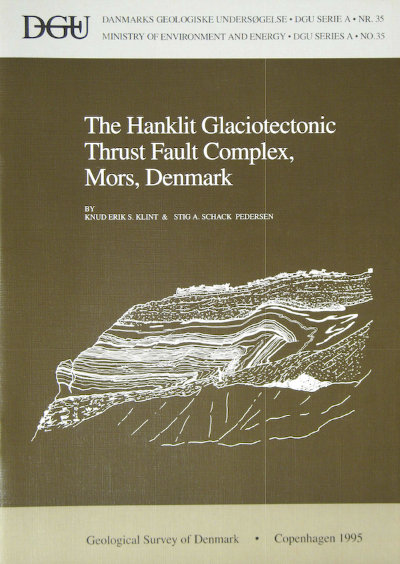The Hanklit Gaciotectonic Thrust Fault Complex, Mors, Denmark
DOI:
https://doi.org/10.34194/seriea.v35.7055Keywords:
Hanklit, Mors, Jutland, Denmark, glaciotectonics, Weischelian, thrust sheet, thrust fault complex, TertiaryAbstract
The Hanklit cliff section is a classical glaciotectonic locality where an excellent cross-section through a thrust fault complex is exposed. The thrust imbrications were thrust from north to the south during a Late Weichselian glacier advance. Three thrust sheets with thickness of more than 50 m are involved in the thrust fault complex. The deposits exposed in the cliff-section comprise ca. 39 m diatomite with ash layers of Paleocene-Eocene age (the Fur Formation), overlain by up to 27 m of Quaternary glacigenic sediments. Common structural features related to compressional thrust fault helts, are recognizable in the glaciotectonic complex, which shows a lateral shortening of more than 40%. Structures created by soft sedimentary deformation due to high water pressure occur in relation to the thrust fault zones. The structural framework is described with the terminology of thin-skinned tectonics and flats, ramps and hanging-wall anticlines are identified in the cliff-section. A balanced cross section has been constructed. Based on this construction the structural model is verified and the glaciotectonic development is interpreted. A geoelectrical investigation has been made to support the construction of the 3-dimensional framework of the thrust complex. This demonstrates that the impressive Hanklit thrust sheet extends for more than 1 km along the strike and is displaced more than 200 m to the south. Superimposed extentional structures, situated above the sole of the Hanklit Thrust Sheet, are interpreted to be related to Tertiary subsidence tectonics.
Downloads
Published
Issue
Section
License
This article is distributed under a CC-BY 4.0 licence, permitting free redistribution and reproduction for any purpose, even commercial, provided proper citation of the original work. Author(s) retain copyright over the article contents.


